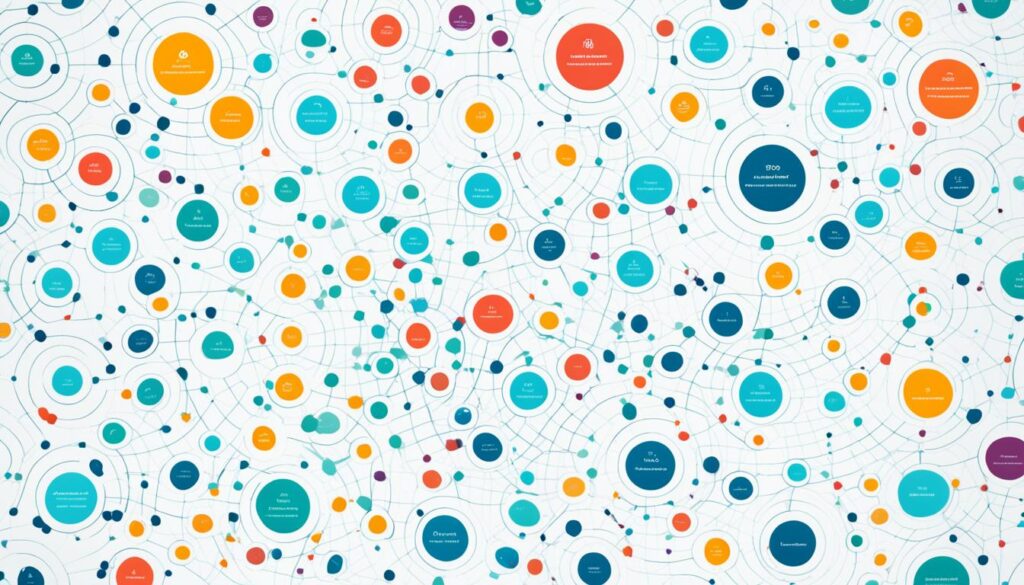“The future belongs to those who prepare for it today.” – Malcolm X. Small and medium enterprises (SMEs) often boost their game by using the latest tech. AI marketing tools have changed the game for businesses, increasing sales and customer interest. For example, Amazon’s smart recommendation engines suggest products uniquely for each customer. Meanwhile, Netflix uses similar tech to keep viewers happy and reduce cancellations.
By using AI in marketing, businesses sprint ahead of the competition. They utilize predictive analytics for customer behaviors to make marketing more personal. This approach not only draws more customer interest but also tunes pricing to boost both sales and profits. Plus, AI helps make quick decisions in real-time and manages stock more accurately. This reduces both excess inventory and shortages.
AI also improves how businesses handle their finances, making fraud detection better and boosting efficiency. It takes over repetitive jobs, letting employees tackle more important tasks. This helps SMEs compete on the same level in a tough market.
Key Takeaways
- AI marketing analytics boost sales and customer engagement for SMEs.
- Personalized marketing campaigns improve customer retention and satisfaction.
- AI predictive capabilities enhance inventory management and operational efficiency.
- Automating routine tasks with AI frees up time for more complex and creative work.
- Real-time analytics aid in informed, on-the-fly decision-making, optimizing marketing strategies.
Introduction to AI in Modern Marketing Strategies
In today’s world, AI has become a key player in marketing. It helps businesses connect with customers more accurately and create personal experiences. It allows small and medium businesses to use AI to make their work easier. This includes more than just doing the same tasks faster. AI analyzes market data and predicts trends, helping businesses grow and become more efficient.
Understanding the Role of AI
AI tools can handle a lot of data. This data includes customer details, their online actions, and social media behavior. A study by Wakefield and Ad Age shows that 47% of people use AI to work better. 49% say AI is vital for improving business results. AI marketing uses techniques like machine learning, automation, and natural language processing. These help in making content, understanding data, and improving customer service. This leads to smarter decisions and strategies.
The Impact on Small and Medium Enterprises (SMEs)
AI has greatly helped SMEs by taking over routine tasks. This lets businesses focus on bigger plans. AI helps in understanding what customers want and spotting market trends. For example, some online stores have seen a 15% sales increase with AI. AI helps businesses organize and focus on their goals better. It also helps car companies spend their marketing money more wisely. This shows how AI is changing marketing for the better.
Now, let’s look at how AI is used in marketing:
| AI Application | Impact |
|---|---|
| Content Generation & Personalization | Enhanced customer engagement through tailored messages. |
| Data Analytics & Forecasting | Improved accuracy in predicting market trends and behaviors. |
| Automation | Streamlined operations and reduced manual workloads. |
| Customer Service & Segmentation | Better customer support and precise targeting. |
More than 3,000 managers worldwide use AI for better KPI management. It showcases the benefits of AI in marketing for SMEs. By using AI, businesses can see faster results, manage budgets better, and adjust to performance data quickly. This prepares them for growth and staying ahead in the market.
The Benefits of Predictive Analytics in Marketing
Predictive Analytics in Marketing takes data to new heights. It reshapes how we reach out to our audience. With it, we create personalized marketing drives. These campaigns increase customer interaction and conversion rates significantly.
Driving Personalized Marketing Campaigns
Predictive analytics fine-tunes marketing to match what each customer likes. It looks at past data to guess what customers will do next. This way, campaigns speak directly to each person. They spark more interest and make marketing more effective overall.
- Utilizes data analysis to understand individual customer preferences.
- Leads to high engagement rates and business growth.
- Enhances targeting with relevant and personalized messages.
Streamlining Customer Segmentation
Predictive analytics makes customer segmentation much sharper. It groups customers by their actions and purchase history. This lets businesses send the right messages to the right people. With better targeting, marketing becomes more cost-effective. This improves both operations and conversion rates.
“Machine learning models can assist in intelligent customer segmentation by finding hidden relationships between customers’ data points and making better clustering decisions.”
| Benefit | Impact |
|---|---|
| Lead Scoring | Increases conversion rates by focusing on high-potential prospects. |
| Customer Churn Prediction | Identifies at-risk customers, allowing for proactive retention measures. |
| Sales Forecasting | Aids in better resource allocation and business decisions. |
| Churn Prevention Models | Helps prevent customer attrition effectively. |
With predictive analytics, we get a deep look into customer habits and market tendencies. These insights help us make smart choices. They improve our marketing and support steady growth.
How AI Enhances Customer Engagement
Artificial intelligence is changing the game by making customer experiences better and improving loyalty. It does this using machine learning and processing language naturally. AI spots trends in customer data. This lets it predict actions and shape marketing to fit each person.
Think about AI chatbots. They give customer service all day and night. They answer questions and suggest things that fit what you like. This boosts how satisfied you are with the service. Quick and smart answers from these chatbots make customers feel valued. And feeling valued is key for keeping customers loyal.
AI also makes ads more targeted, efficient, and cost-effective. This approach tailors marketing to each customer, enhancing their experience. Marketing that learns as it goes is crucial here. It uses data to predict and help marketers choose wisely.
AI is also changing how user experiences are studied, leading to better and more engaging customer paths. It can better predict what customers will do next and talk to them in a more personal way. Getting messages that really speak to you improves your experience and keeps you coming back.
| AI-Driven Feature | Impact on Customer Engagement |
|---|---|
| AI-Powered Chatbots | Provide 24/7 support, resolve queries quickly, and offer personalized recommendations. |
| Ad Targeting | Increases precision and cost-effectiveness, enhancing personalized marketing efforts. |
| Predictive Analytics | Forecasts behaviors, tailor strategies, and improves overall customer experiences. |
| Customer Segmentation | Utilizes AI to dynamically segment audiences and create tailored communication strategies. |
In summary, AI creates a stronger bond between companies and their customers. It does this by giving insights for personal and impactful chats. As AI gets better, we’ll see even more improvement in how customers engage. This leads to more loyalty and business success.
Data-Driven Decision Making with AI
Businesses are now using AI to understand large amounts of marketing data better. This allows them to make decisions based on data. With tools that predict outcomes, we understand customer behavior better. This means better marketing strategies.

AI-Powered Analytics Tools
AI and machine learning have brought us advanced tools like MapReduce and Apache Spark. These tools help analyze large amounts of data quickly. They show us key insights about what customers want and do.
By predicting what happens next, we can make smarter choices about prices and promotions. This helps in making content that really speaks to people.
Leveraging Customer Data for Marketing Insights
Today, we have more data than ever thanks to digital tech. AI helps us handle this data well. It uses algorithms and databases like Cassandra to manage all the information.
With a good handle on data, companies can tailor their marketing. They can also improve campaigns in real time. This leads to better customer experiences and more effective marketing.
Predictive analytics is changing how we market. It’s helping small and medium businesses grow and beat the competition.
Using Machine Learning for Marketing Automation
Machine learning is a key part of AI that’s changing marketing automation. It helps with efficiency and predicting marketing outcomes. This tech makes marketing work better. It lets brands use their resources well and reach out to people right on time.
About 50% of leaders say machine learning lets them offer better to customers using their data. More people are putting money into data and analytics now than before. This shows how crucial machine learning has become in marketing today.
Companies using machine learning make their email campaigns smarter. They make shopping personalized, which draws customers in more. These models look at lots of data to guess how customers will act. This helps companies send the right messages to the right people.
Top executives see the edge AI and machine learning give. They stress the importance of these in the marketing tech world. Recent studies show AI and ML cut down the time to get results and boost performance.
Let’s look at a detailed comparison:
| Key Focus Areas | Laggards (5%) | Leaders (50%) |
|---|---|---|
| Data-Driven Insights | Minimal | Advanced |
| Predictive Analytics Utilization | Low | High |
| Operational Efficiency | Average | Optimized |
| Customer Value Propositions | Limited | Enhanced |
The table shows that industry leaders use marketing automation for a competitive edge. By investing in machine learning, companies boost their effectiveness. They get better insights and can run smarter marketing campaigns.
Predictive Customer Segmentation Techniques
Predictive customer segmentation is changing the marketing game. By using AI, businesses can group their customers based on shared characteristics or behaviors. This approach lets companies tailor their marketing efforts. They can connect better with each segment, improving customer experiences and marketing effectiveness.

Identifying Key Customer Segments
At the forefront of predictive customer segmentation is identifying key segments. These segments can be based on demographic, psychographic, geographic, behavioral, or firmographic data. Through predictive analytics, companies can discover which customers might buy products, enjoy promotions, or leave. This knowledge helps companies use their marketing resources wisely. They aim to create personalized interactions and increase customer satisfaction.
Enhancing Targeted Marketing Campaigns
Targeting specific customer segments accurately helps small and medium-sized enterprises (SMEs) create successful targeted marketing campaigns. This strategy can lead to more customer loyalty and better retention rates. It’s all thanks to personalizing marketing messages. Businesses that continuously analyze customer data can improve their segmentation strategies over time. Thus, they keep their messages fresh and relevant. This focused approach is key to marketing efficiency. It ensures the right message meets the right audience when it matters most.
| Segmentation Type | Characteristics |
|---|---|
| Demographic | Age, gender, income, education |
| Psychographic | Lifestyle, values, interests |
| Geographic | Location, climate, urban/rural |
| Behavioral | Purchasing patterns, brand loyalty |
| Firmographic | Industry, company size, revenue |
Implementing AI in Marketing Campaigns
Today’s digital marketing is changing fast, and AI helps make campaigns more personal and engaging. By using dynamic content generation and behavior-based retargeting, marketers can make user experiences better. This leads to more people buying things.
Dynamic Content Generation
AI makes content change in real-time, based on what users like and do. This approach means messages hit home harder, which makes people more interested and likely to stick around. Brands like Spotify and Amazon are great at making content that changes for each person. This makes customers happier and more loyal.
Behavior-Based Retargeting
This AI technique looks at user behavior to target ads and personalized email campaigns better. It focuses on people who showed interest but haven’t bought anything yet. Using tools like Google Ads’ retargeting lets companies bring back customers. This increases sales.
| Aspect | Benefit |
|---|---|
| Dynamic Content Generation | Personalizes content in real-time for optimal user engagement. |
| Behavior-Based Retargeting | Targets users with tailored ads based on previous interactions. |
| Personalized Email Campaigns | Increases open rates and conversions by customizing messages. |
| AI-Driven Content Creation | Enhances the relevancy and impact of marketing materials. |
Using AI makes marketing campaigns connect better with customers and run more smoothly. By adopting AI, brands stay ahead and connect in meaningful ways with their people.
Predictive Modeling for Marketing Campaigns
Predictive modeling uses AI to guess future market trends and consumer actions. It makes our marketing strategies smarter, reaching people more effectively. We can connect better, turning interest into action.
Understanding data analytics maturity is our starting point. It goes from descriptive to diagnostic, then predictive, and finally prescriptive analytics. Predictive analytics helps us look into vast customer data, making accurate forecasts for our strategy.

Predictive analytics brings many advantages. It improves how we model campaigns and segment customers smarter. It also makes lead prioritization efficient and personalizes the customer journey. With predictive modeling, we make better choices and use resources wisely. Here are some important uses:
- Customer Segmentation: AI helps us pinpoint the right audience with content that grabs their interest.
- Churn Prediction: We can foresee and act on chances of customers leaving, keeping them close.
- Lead Prioritization: We focus on leads with a high chance to convert, boosting our marketing’s effect.
L’Oréal, Aydinli, and IDT have seen great success using predictive modeling. For example, L’Oréal taps into Synthesio for beauty trend forecasts. Aydinli uses Acquia for spotting customer groups. IDT relies on Optimove for keeping customers and forecasting churn. Their successes are significant:
| Company | Outcome |
|---|---|
| Aydinli | $50,000 additional per campaign |
| IDT | 50% increase in new service purchases |
| Digitally-native company with WNS | 38% improvement in lead conversion |
Predictive modeling uses methods like decision trees and neural networks. These help in making high-accuracy predictions. The techniques let us fine-tune our strategies quickly, keeping our content fresh and interesting.
In conclusion, marketing benefits greatly from predictive modeling. It sharpens our foresight into what customers want, making our campaigns more effective. By staying on top of trends with AI and creating content that resonates, we stay leading in the market game.
Optimizing Pricing Strategies with AI
Artificial intelligence has changed how we set prices today. It uses lots of data to find the best price for items or services. This helps businesses stay ahead and make more money.
AI-Driven Price Adjustments
AI makes real-time price changes based on the current market, demand, and what’s in stock. This keeps prices up to date, helping businesses stay competitive and make more money. AI also creates personal prices for each customer by understanding what they like and how much they spend.
Understanding Price Elasticity
Knowing about price elasticity is key for smart pricing. AI studies data to see how changing prices affects demand. This helps businesses find the right price for their products. It makes sure they sell a lot without losing money.
AI even looks at customer details to set specific prices based on people’s data. But, it’s important to watch out for problems like data bias and how customers feel about changing prices. Still, using AI to set prices helps understand what customers want and reach business goals.
The Future of AI in SME Marketing
The world of SME marketing is changing fast, thanks to AI. Before, SMEs faced big challenges like high expectations, average designs, and small budgets. But now, AI tools are changing the game. They offer better teamwork, smart analytics, exact targeting, and smoother design work.
The future of AI marketing is bright for SMEs. It lets them excel in the tough digital market. With AI, businesses can grow more and beat rivals by targeting more accurately and forecasting trends. AI helps foresee market changes and plan strategies, giving SMEs the upper hand.
As we move towards digital transformation, AI tools are key for growth. They improve decision-making between SMEs and designers. This speeds up creating custom marketing materials. Plus, AI insights help understand the audience better. This makes the content more personalized and powerful.
Looking forward, AI will be a main part of marketing for SMEs. As AI tools get easier to use, small businesses will benefit greatly. By using AI, SMEs can lead their sectors, keeping their edge in the fast-changing digital market.



